The Microsoft Surface Pro (2017) Review: Evolution
by Brett Howse on June 15, 2017 9:00 AM ESTGraphics Performance
With the Core i7-7660U, we finally get a chance to look at the Intel Iris Plus Graphics 640 in a notebook. On a typical U series Intel Core processor, there are 24 execution units (EUs) available, but the Iris Plus doubles that to 48. Despite having the same TDP, having twice as many EUs running should still be a big boost to performance, as even if they need to throttle, there are twice as many, so they can run slow and wide and still fit in the TDP. The base frequency for the graphics is 300 MHz, with a 1.1 GHz boost frequency.
The addition of 64 MB of eDRAM is also a large benefit to graphics, which needs a lot more memory bandwidth than the CPU, and having this extra eDRAM as a cache for the GPU is a big benefit to the Iris Plus graphics.
In the graphs below, make note that the Dell XPS 15 has a GTX 960M graphics card, which should win pretty handily, but the Surface Book has a smaller GT 940M with 2 GB of GDDR5, so it will be interesting to see the performance difference between the integrated Iris Plus Graphics 640, and a discrete entry-level GPU.
3DMark
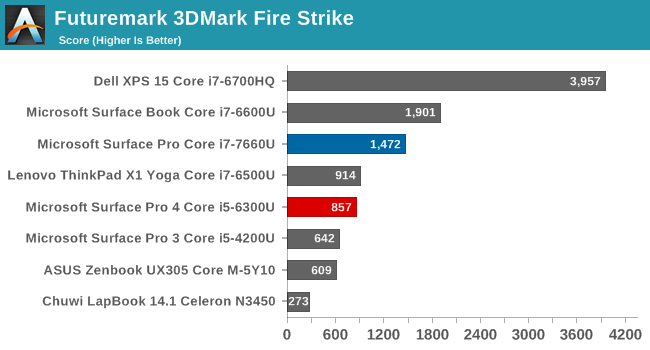
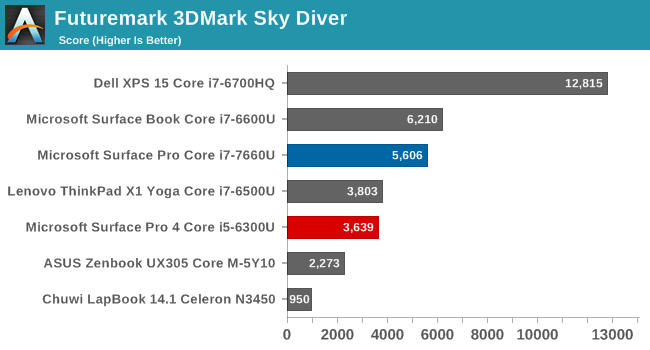


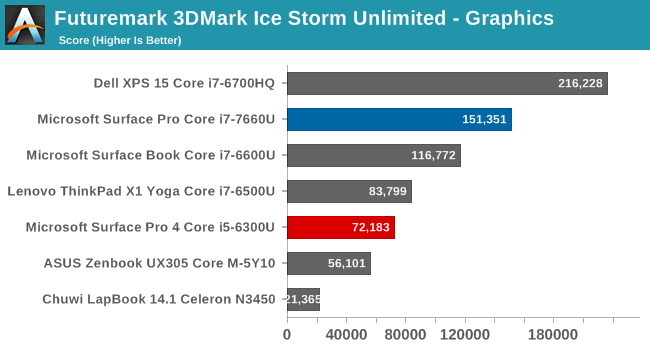
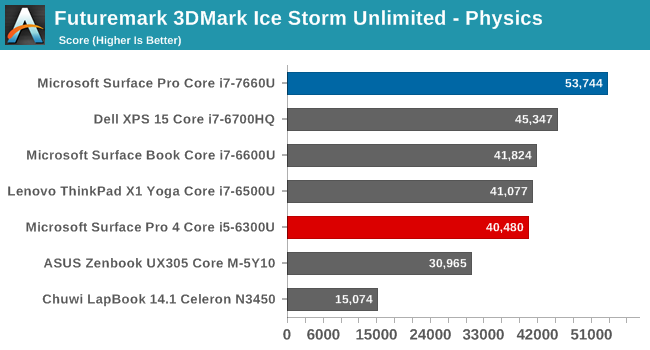
Futuremark’s 3DMark continues to be developed, and new tests have been added for higher end systems, but for our purposes on this review, the normal results will do just fine. Each of the tests move from quality to performance, with Fire Strike being the most demanding, and Ice Storm Unlimited being a smartphone or tablet test. The GT 940M in the Surface Book still manages to hold an edge on the more graphically demanding tests, but is then surpassed as the workload gets easier, and the test becomes more CPU bound. Compared to the non-Iris Ultrabooks though, the i7-7660U delivers a lot more performance.
GFXBench
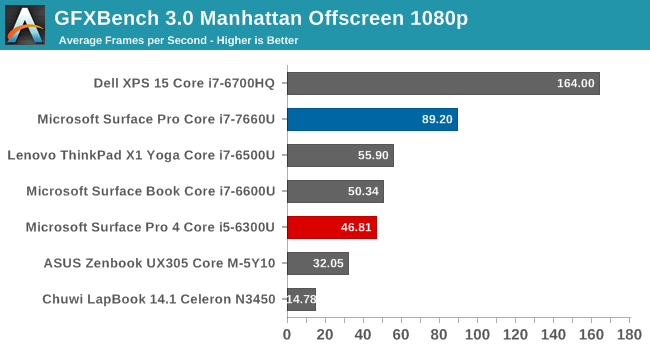

Another synthetic, Kishonti’s GFXBench also continues to evolve, with new tests being added to provide more stressful tests than the older T-Rex and Manhattan ones. Since we don’t have any comparison data, for now we’ll stick with the older tests while we fill out the data gaps. The Intel Iris graphics pull out a hefty lead here.
Dota 2
Valve’s Dota 2 online area game continues to be our go-to game for testing systems with lower end graphics, since it has a low barrier of entry, and is quite playable at low settings even on a system with integrated graphics.
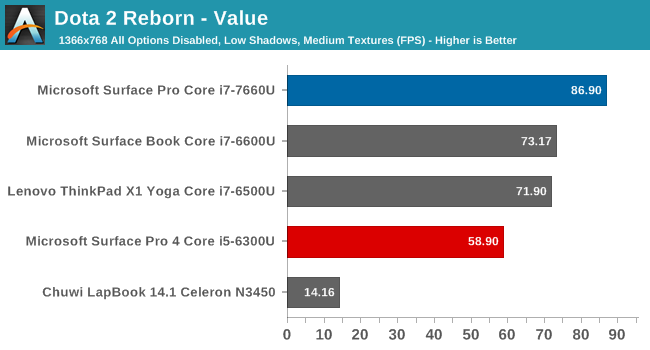
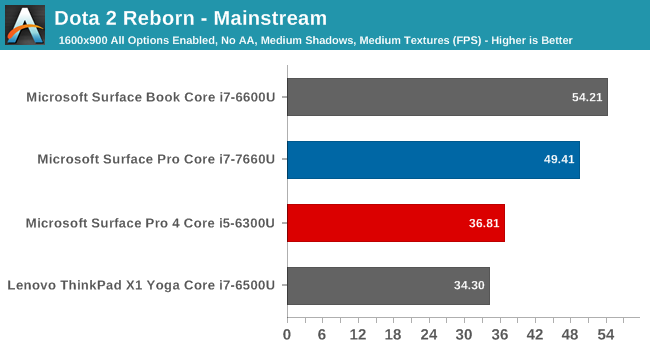
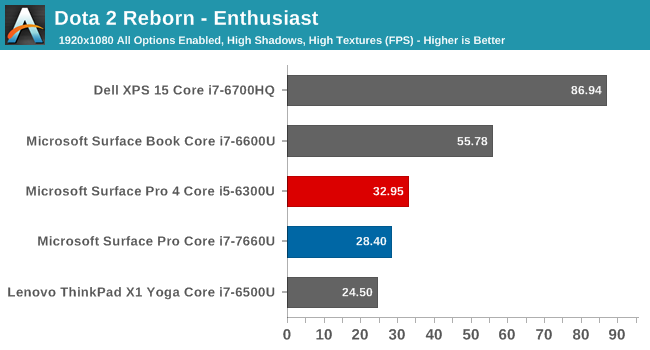
Here the Iris Plus Graphics do not bring the kind of improvement that would have been hoped for. At lower settings, they are very capable, and the extra CPU speed from the i7-7660U helps break the CPU bound barrier of the other systems, but once the graphics are turned up, the U series chip runs into the thermal barrier of only having a 15-Watt TDP. Compared to the Microsoft Surface Book, with it’s discrete GT 940M GPU, there’s really no contest, since that GPU alone would have 20-30 Watts of TDP available to it. The Iris does allow a lot more graphics potential, but for longer duration requirements, it may not offer much of an upgrade.
Graphics Conclusion
It’s great to finally be able to test a system with a U Series CPU and Iris graphics, and the results are quite impressive. It’s not quite up to par with even a low-end discrete GPU, but compared to the other integrated GPUs available in the other Ultrabooks, the Iris really brings the performance up a step. For light gaming, it should work well, but the extra eDRAM can help out on practically any task. The extra EUs available would also be of benefit to any productivity app that can leverage the GPU for some of its compute.
Storage Performance
PCIe SSDs have been the name of the game for the last couple of generations of Ultrabooks, but they’ve generally been shipping in the M.2 form factor. Microsoft has gone a different route with the new Surface Pro, by moving to a much smaller BGA SSD in the Samsung PM971.
The benefits of going this route are mostly packaging. The BGA SSD is significantly smaller than any M.2 SSD, especially the 2280 versions that are the most common. The drive is also most likely more energy efficient than the fastest SSDs available today, which should help with battery life.
There is likely only one downside to the PM971 BGA SSD, and that is performance. While still much faster than a SATA SSD, the PM971 is limited to a PCIe 3.0 x2 link, which is going to impact the maximum read and write speeds.
As you can see in the CrystalDiskMark test, the maximum read speed is well under something like a Samsung SM961. This may seem like bad news, but in fact the PM971 actually outperforms the same size PM951 drive which was easily the most popular SSD found in Ultrabooks until recently. The PM971 is 48 layer TLC NAND, with reasonable write speeds, and other than the lowered maximums created by the PCIe link being x2 instead of x4, the performance is quite good.
When you look at a device like the Surface Pro, where space is at a premium, these are the kinds of compromises that make sense when you consider that they’ve increased the battery capacity by 15%, and despite going with a compact SSD, they’ve still increased performance over the outgoing model assuming it had a PM951, which it seemed most did.


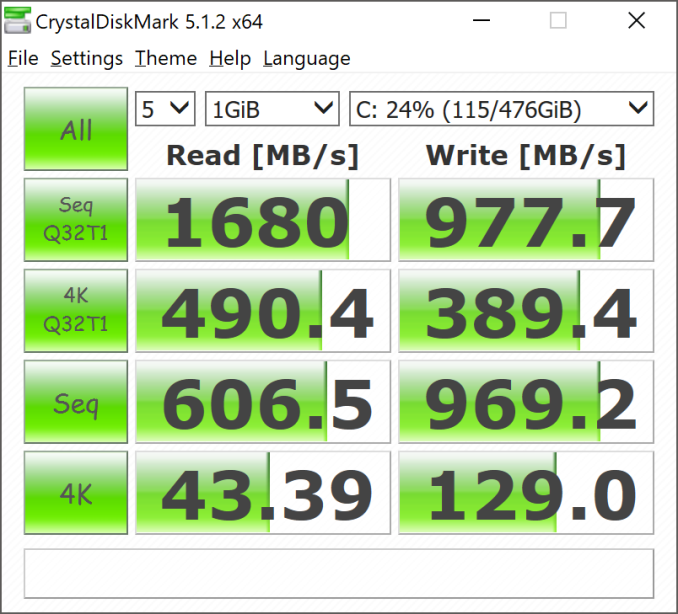








124 Comments
View All Comments
malireddyk - Monday, September 18, 2017 - link
LOLKPOM - Sunday, June 18, 2017 - link
Yes please review the new MBP and MB. The 2016 MBP review seems to have slipped through the cracks but I would like to know how good or bad a job Apple did with the thermals in the Pro models.tipoo - Monday, June 19, 2017 - link
One of them had tweeted it was in the works, but that was before the 2017 refresh came out, not sure if they'll jump to the new ones or finish with the 2016.ozzuneoj86 - Thursday, June 15, 2017 - link
That isn't even close to cobalt blue.Dug - Thursday, June 15, 2017 - link
I really liked this. Very concise, informative, and to the point.Only thing I would change is the graphs. Red being the dominant color, I think the new Surface Pro should have been labeled with it instead of blue.
Dug - Thursday, June 15, 2017 - link
Do you find this comfortable as a laptop replacement? Meaning actually using it in your lap instead of a desk? Or is it too top heavy and awkward with the kickstand and lightweight keyboard?Toss3 - Thursday, June 15, 2017 - link
I own the SP4 (i7+16Gb ram) and it can definitely replace a laptop and I do use it on occasion in my lap, but a regular laptop is definitely more suited for the task, so if you don't need a hybrid, I'd go for a regular laptop. Don't get me wrong I love the thing and it works brilliantly as a tablet when lying in bed or sitting on the sofa, and the keyboard is awesome when you need to do some writing/excel/other type of work done. The pen is also an awesome thing to have when reading pdfs/articles/books, or when working in photoshop. But if you don't need any of those things, I'd just go for a more powerful laptop.Brett Howse - Thursday, June 15, 2017 - link
I can use it on my lap if needed, but anything with a detachable keyboard isn't great for that experience. If you need to type in your lap a lot, this isn't for you. It's more for boardroom to boardroom.BillBear - Thursday, June 15, 2017 - link
Those keyboards are going to wear horribly, just as Alcantara does when automakers put in in places that people have to handle, like steering wheels or gearshifts.https://www.youtube.com/watch?v=aebUNgMhQV4&t=...
R3MF - Thursday, June 15, 2017 - link
makes the surface laptop a deeply unappealing choice, unless you're happy to upgrade your laptop every 2 years, as your friendly MS sales-rep would advise you to...